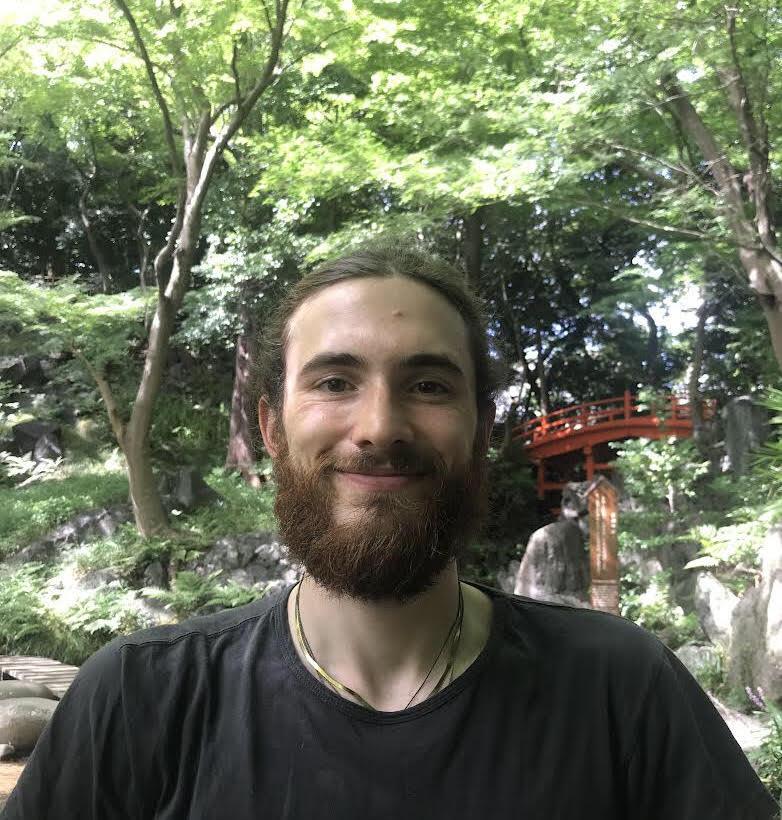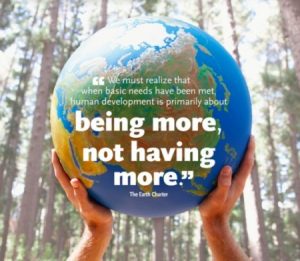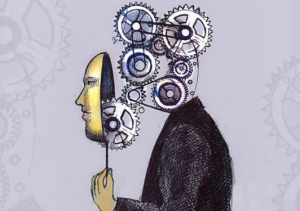Before joining an expedition into largely uncharted terrain, getting to know your guide is recommended. This article retraces the author’s path into socially engaged Buddhism, offering an insight into the evolution of Digital Bodhisattva through the formative experiences of its dutiful scribe.
In following this thread back to the beginning, we arrive together at a clear vantage point from which the more deliberate work of cloud-based pathfinding may proceed. Ever mindful that the gift of a reader’s attention is not to be wasted, we open with an as-yet-untold part of the tale—how I was rewired by socially engaged Buddhists.

Where it began
Back in late 2019, before the Earth had been ravaged by COVID-19 angst, I sat as a wide-eyed foreign exchange student in a brightly lit Keio University classroom near Tokyo Tower. Before me an unassuming American from St. Louis had just delivered a 45-minute presentation that would change the course of my life.
Theodore Mayer, director of the INEB Institute, wrapped up his sharing on the School of English for Engaged Social Service (SENS) with an open invitation for curious students to apply as language tutors for the program’s upcoming cohort. After asking some eager questions I applied, and some months later found myself in Thailand on the lush grounds of Wongsanit Ashram—in the company of a group of tenacious Asian activists in a container that fundamentally remolded my understanding of the world and my role in it.
The heart-brainchild of the International Network of Engaged Buddhists (INEB), the School of English for Engaged Social Service was inspired by Vietnamese Zen Master Thich Nhat Hanh’s early 1960’s School of Youth and Social Service—a grassroots relief organization of 10,000 volunteers based on the Buddhist principles of non-violence and compassionate action. Courageously responding to the devastation of the Vietnam War, Thich Nhat Hanh’s school mobilized youth as agents of social change by teaching an activism grounded in the ethical framework of the Buddhadharma.
In Thailand, I found myself teaching high-school grammar to compassionate dissidents of the Chinese state, drinking tea with enthusiastic forest monks, and having long, candle-lit conversations with civil society leaders from Myanmar. Between language lessons our group visited a rainbow of grassroots organizations, with leader after leader reinforcing the value of a strong spiritual foundation for effecting positive real-world change. Laughing with an unforgettable resonance, I had never met people this plugged in to the dynamics of life at large.
The stories I heard from these new friends—of smuggling political poetry out of prison, ordaining thousands of trees as environmental protection, and daring resistance in the face of brutal Southeast Asian dictatorships—rattled the dainty worldview that had encased my Western mind. I cried with these new friends, I rejoiced with these new friends, I haven’t been the same since.
These experiences completely re-contextualized my understanding of the role that contemplative teachings play in shaping our engagement with the world. Instead of sitting quietly and letting things bumble along the way they always have, I met socially engaged Buddhists that saw the highest expression of their practice as the transformation of collective suffering into empowerment and liberation from oppressive systems. This was a full-blown technicolor immersion in the world of boots on the ground spirituality, opening a new view of rich inner life as the integrated determination to ripple harmful systems with wise and compassionate action.

Entering the digital dojo
Just as the program in Thailand was coming to a close, the specter of COVID-19 fell and I was forced to abandon my second semester in Japan. While the following months of lockdown and study-abroad-from-home were bizarre, it was during this time of unusual digital saturation that the deeper structure of what I had been exposed to began to sink in.
Thanks to the almighty gift of Zoom, I was able to simultaneously continue my studies and join a series of online focus group discussions hosted by INEB on the intersection of technology with personal and social well-being. Playfully titled the first Digital Bodhisattva Series, I participated enthusiastically, recognizing the nutrient-dense overlap between these topics and the “Buddhism and Social Change in Contemporary Asia” course being taught virtually by Jonathan Watts, the same instructor/instigator who had convened the autumn classes that led to my world being turned upside down in Southeast Asia.
A longtime member of the INEB Executive Committee, with 30 years of experience in Dharmic activism across Asia, Watts’ course was a genuine tour de force. With topics ranging from “Buddhist Responses to Modernity” to the “Emptiness of Gender,” I was unexpectedly reintroduced to many of the luminaries I had met in Thailand—only now with a better contextual understanding of their impact and innovative methodology.
While this intensive education in the engaged Buddhist underground was taking place, our Digital Bodhisattva group began analyzing the eye-opening Social Dilemma documentary released by the non-profit Center for Humane Technology. Skewed power dynamics, engineered structural violence, and the manipulation of awareness by extractive economic force were all themes that emerged in high relief as patterns of our modern social media atmosphere and entrenched global undercurrents of greed, anger, and delusion.
This timely confluence of the largely analogue socially-engaged Buddhist world and recognition of the need to address novel forms of digitally conditioned suffering condensed into a felt sense of direction that I had not yet known existed. During those long months of societal hibernation, it seemed that I had stumbled into a digital dojo for spiritually grounded activism that came to its fullest expression in our virtual study of the Four Noble Truths.

A social view of the Four Noble Truths
In the early 1990s, Watts helped coordinate the Think Sangha, a proto- “think tank” of INEB scholar-activists concerned with developing a mature Buddhist social theory capable of addressing the many spiraling challenges of modernity. Through numerous conferences and publications, a comprehensive outline of the group’s approach was articulated in the“Four Noble Truths as Experiential Social Praxis,” which has since guided decades of grassroots activism on a small and beautiful scale.
From life-changing gender-based violence interventions to the heart-wrenching “charnel ground” work of suicide prevention and end-of-life care, this model has demonstrated its utility across a diverse array of seemingly intractable contemporary issues. This is because its power does not lie in the authority of a great facilitator, spiritual teacher, or esteemed religious doctrine. Rather, its effectiveness stems from the reminder that these teachings were originally intended as a pragmatic toolkit for real-world problem-solving.
Somewhat dazzled by this skillful synthesis of head, heart, and hands, I learned that the vision extended well beyond a neat way of thinking, informing the operative methodologies of NGOs and civil society groups connected to the International Network of Engaged Buddhists. Soon I was pestering INEB to hire me, promising the dutiful application of my liberal arts training to any task they threw my way in exchange for the opportunity to delve deeper into this world of socially engaged Buddhism.

Toward cloud practice
With stubborn persistence and the support many helping hands, a job was created through which I entered a ragtag lineage of office farangs (Thai for Western foreigners) similarly thrown into the deep sea of NGO operations. From barely floating on the choppy surface of admin to gradual swimming with the flow of projects, Digital Bodhisattva evolved into a practice of occasional free-dive exploration—intentionally feeling out the fluid terrain of socially engaged techno-Dharma. Now accustomed to the waters and returned to an initial anchoring in the Four Noble Truths, we are set for a more sustained adventures into the depths.
Drawing on the resourcefulness and creativity of Think Sangha’s method, it is the intention of the following series of articles to apply this innovative approach directly to the digital domain, where many of our old analogue problems are being encoded and amplified into monstrous new realities. Demonstrating the utility of the Four Noble Truths as a sense-making and problem-solving framework, we endeavor to build a practical bridge between the grassroots wisdom of socially engaged Buddhism and cloud-based chaos of modern life online. Connecting these two spheres, we plant the term Cloud Practice at the trailhead, venturing forth with the intention to lay a fresh path into the glitchy landscape beyond.
See more
International Network of Engaged Buddhists (INEB)
The INEB Institute
The Four Noble Truths as Experiential Social Praxis (Contemporary Buddhism in Japan & Asia)
Entering the Realm of Reality: Towards Dhammic Societies (Internet Archive)
Digital Bodhisattva (Facebook)
Digital Bodhisattva (Clubhouse)
Digital Bodhisattva Initiative (Linktree)
Related features from BDG
A Wet Blanket Mantra for Modernity: In Conversation with Gregory Pettys
Spatial Samsara: The Apple in the Garden
Praise for a Hopepunk Psalm
Related videos from BDG
BDG Special Issue
Digital Dharma – Buddhism in a Changing World












